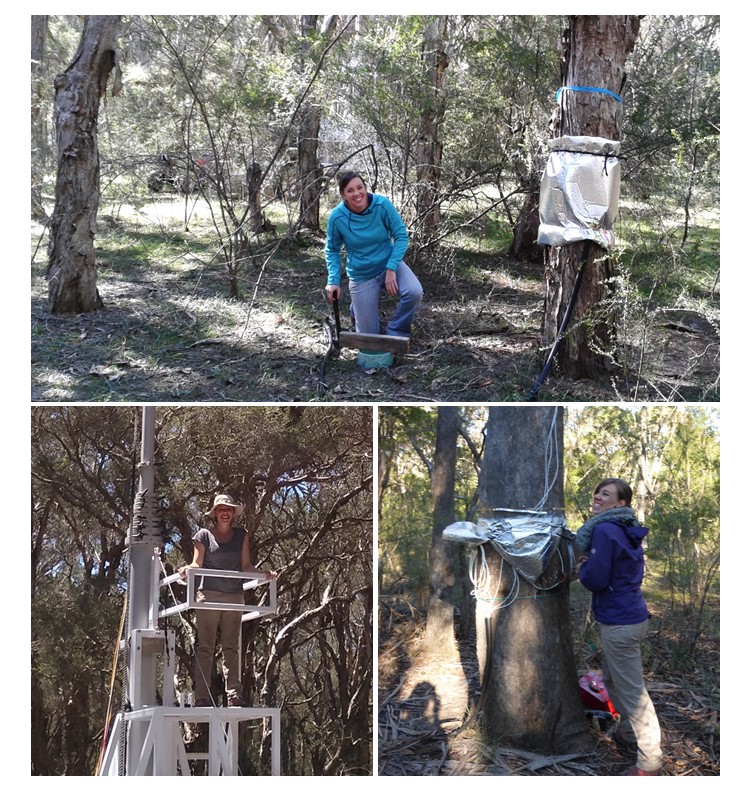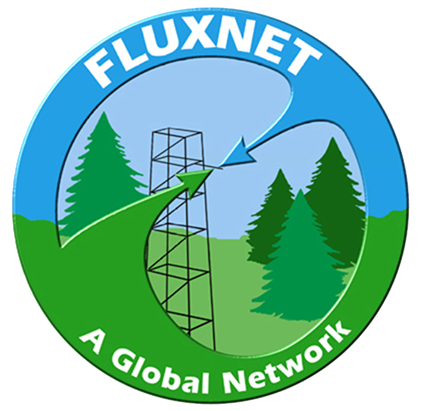This month, we are pleased to interview Anne Griebel. Anne is an ecologist that was introduced to flux research during an internship at the USGS while doing her Masters in Physical Geography at the University of Bonn, Germany. Her first task was assisting with setting up an urban flux tower – and she was hooked from that day on. Anne then moved to Australia for her dissertation on ‘New approaches to monitor growth dynamics in forests’ at the University of Melbourne, and is about to complete her first postdoc at the Hawkesbury Institute for the Environment at Western Sydney University. Anne has worked across a large range of ecosystems, from urban grasslands to prairies and forests, which fuels her interest in synthesis studies. To know more about Anne, please see her personal Website and ResearchGate profile.

Please tell us about your most recent studies. What’s the main take-home message? Or, what’s exciting about the study?
My most recent studies focus on unraveling the role of spatial heterogeneities on carbon, water, and energy fluxes. During my Ph.D. research, I discovered that the magnitude of carbon and water fluxes varied strongly with wind direction, which caused large variation of annual budgets related to how often which part of the forest was sampled. I proposed a method that provides ‘standardized’ budgets based on an average wind pattern to remove the sampling variation due to variation in winds (Griebel et al., 2016), which I presented at AGU in 2015 and for which I was awarded an outstanding student presenters award of the Biogeosciences section.
This encouraged me to keep working on this topic during my postdoc, and I recently synthesized how a common biotic disturbance (mistletoe) has the potential to modify stand properties and affect the water redistribution within host trees, as well as ecosystem-scale carbon, water, and energy cycling (Griebel et al., 2017). Further, I am tackling site heterogeneity in my ongoing studies by using a paired-tower set-up, where I deployed a mobile flux tower in an adjacent patch to our OzFlux tower to simultaneously monitor two portions of a heterogeneous ecosystem. In addition, I made use of the data wealth within the FLUXNET2015 database, for which I developed a standard means to quantify the spatial homogeneity of each flux site in conjunction with remote sensing data, along with three practical solutions to account for sampling variations over heterogeneous ecosystems. I presented both approaches at the recent OzFlux and the AGU Fall meetings, including the OzFlux data processing workshop and NEON’s Eddy4R workshop. Both papers are currently in peer review, and until they are published you can read more about my recent research findings on my personal website.
The main take-home message is that most sites are actually heterogeneous and that this significantly affects estimates of mean biome carbon sequestration that progress through to estimates of the terrestrial land sink size. But the good news is that it is straightforward to attribute the contribution of sampling variations over heterogeneous ecosystems by revising the way we constrain the budgets for our flux sites.
As you work more with flux data (e.g., FLUXNET2015), what skills do you feel you need to acquire (either in the past or near future) to make your studies more effective? What advice would you give to other new beginners?
Becoming proficient with a programming language has become an invaluable tool for handling flux data from individual towers, but especially when undertaking synthesis activities across multiple flux sites as is enabled by the manifold of collaborations among the global flux community. Nowadays, we have a wealth of data available, along with a range of fabulous and freely available tools contributed from members of the community to help analyze it. My advice to new beginners is to choose a programming language that is best suited for the type of research you are interested in and to build upon the vast resources that are already available. I was lucky enough to be able to use our Australian flux data processing software (former OzFluxQC, now PyFluxPro) to do the heavy lifting when I started processing my own flux tower data, and am currently in the process of giving back my share with an R-package that will allow for an easy application of the proposed budgeting approaches and that will be implemented as Eddy4R.fast into NEON’s R-Docker. As a young scientist, you won’t need to reinvent the wheel anymore, use the tools that are there and enjoy the collaborations within this fantastic network!
Who have been your mentors and how have they helped you arrive at where you are today?
My passion for flux research was ignited by Dean Anderson, who introduced me to the world of eddy covariance as a research volunteer at the USGS. Dean provided me with a perfect balance of mentorship, discipline background and the most enjoyable work environment one could think of. His experienced guidance was pivotal to getting me interested in this foreign, but intriguing research world, which is why I didn’t take long to return to Colorado to complete my Master’s thesis research under Dean’s guidance and the supervision of Joerg Loeffler at the University of Bonn.
Stefan Arndt’s and Lauren Bennett’s mentorship at the University of Melbourne was invaluable for my transition toward an independent researcher, as they provided me with a stimulating research environment while also encouraging independent thinking during my Ph.D. process. They introduced me to the Australian-New Zealand flux community, among which the personal dedication from Peter Issac and James Cleverly was essential to help me tackle the hurdles that come with a non-trivial site.
During my postdoc, it was Elise Pendall and her continuous encouragement to engage in conceptual thinking, graduate teaching, early career mentorship and public outreach that proved crucial to my personal career development, and which transformed me from a scholar into a well-rounded early career scientist. I would not be where I am today without the inspiration from my previous mentors, my peers and the healthy flux research environment of which I am proud to be part of.
What resources do you think the flux networks or communities (e.g., Fluxnet, OzFlux) have provided or could potentially provide to help your studies and career?
The personal interactions and the digital resources that my local flux network and the international flux community have provided me were absolutely key to the success of my research. The OzFlux data processing workshops were priceless in providing me with a solid theoretical basis and in kick-starting my flux data processing skills, while peer to peer discussions during the annual OzFlux meetings and international conferences such as the EGU Meeting or the AGU Fall Meeting facilitated new collaborations that kept me motivated and engaged in my research endeavors. I never had the chance to participate in the Fluxcourse, but it sounds like a wonderful opportunity for emerging scientists to get introduced to the most recent developments in eddy covariance and related modeling, to upskill on flux data processing and to network among the broader flux community.
What are your career goals and aspirations?
I am transitioning from my current postdoc in the Pendall lab into my new position in the Boer lab that will allow me to advance my existing ecological skill set with the newest developments in remotely piloted aircraft systems. I am excited about the possibility of using drones to complement ecosystem-scale flux observations, and looking forward to strengthening the link between ground-based and remotely sensed observations to overcome the inevitable scale mismatch between local and regional measurements. I hope that my passion for research, teaching, and mentorship will allow me to stay in academia in the long term so that I can keep tackling many more of the exciting environmental challenges that we are all facing in this changing world.
References and press release
- Griebel, L. T. Bennett, D. Metzen, J. Cleverly, G. Burba, S.K. Arndt. (2016). Effects of inhomogeneities within the flux footprint on the interpretation of seasonal, annual, and interannual ecosystem carbon exchange. Agricultural and Forest Meteorology, 221, 50-60.
- Griebel, D. M. W. Watson, E. Pendall (2017). Mistletoe, friend and foe: Synthesizing ecosystem implications of mistletoe infection. Environmental Research Letters, 12, 115012.
- Press Release: “Mistletoe is “kiss of death” to drought-stressed trees”. AGU press office, 11 Dec. 2017. https://news.agu.org/press-release/agu-fall-meeting-mistletoe-is-kiss-of-death-to-drought-stressed-trees/ (last visited 30 March 2019)
Relevant links
- Personal website: https://annegriebel.home.blog/
- Researchgate: https://www.researchgate.net/profile/Anne_Griebel
- GoogleScholar: https://scholar.google.com.au/citations?user=lj8B93EAAAAJ&hl=en
